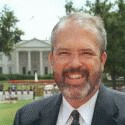
|
|
 |
| Washington Notebook |
| April 7, 2005 |
Vol. 2, No. 13
|
| * Send to a friend | ? Get e-mail alerts | 1 Archives | 8 NCRonline.org |

Washington
"[W]hite Catholics [voters] should not be caricatured as traditional social conservatives, as among the evangelical churches. They are fairly tolerant of America's social diversity, including homosexuality. They are open to pro-choice Democrats who emphasize fewer abortions. And they firmly align with progressive development and science, like stem cell research, even when opposed by the church."
Stanley Greenberg,
|
By Joe Feuerherd Democrats should not abandon "traditional Catholics" but instead meld a message based on party principles that can appeal to this once core constituency. So says Stanley Greenberg, former Bill Clinton campaign pollster, in a 17-page memo on "Reclaiming the White Catholic Vote." Greenberg's not the only Democratic insider worried about the continuing decline in the party's appeal to Catholics. In fact, when it comes to religion, and particularly the "Catholic Vote," Democrats have become true believers. It's more than a trend. It's a movement:
The question, therefore, is no longer whether Democrats should appeal to the socially-conservative but economically-liberal voters who were once a core part of their constituency, but how they can do so without alienating the party's culturally-liberal base. Greenberg's analysis, based on a survey of more than 1,000 white Catholic voters nationwide, begins to point the way. In 1996, Greenberg notes, Bill Clinton carried the white Catholic vote by seven percentage points; in 2000, Al Gore lost the vote by seven percentage points, while, in 2004, John Kerry lost "by a striking 13 points." "What is this all about?" asks Greenberg. He provides some answers. The "defectors" -- white Catholics who voted for Clinton but not for Gore or Kerry -- "are more blue collar (that is, non-college educated and lower income) and primarily identify themselves as moderate or conservative," says Greenberg. They're likely to oppose gay marriage, gun control, and abortion and they are more likely to attend Mass than other Catholic Democrats. But are also "very uncomfortable with Christian evangelical groups" and "despite their strong opposition to gay marriage, they believe homosexuality should be accepted rather than discouraged." Most significantly, perhaps, the white Catholic electorate's views about the church correlate directly with their voting patterns. "Modernizers," those who want the church to "adapt to an evolving society" make up 46 percent of white Catholic voters (and generally support Democrats). "Traditional Catholics," those who want the church "to return to its roots and become more tied to traditional church teaching" account for 47 percent of the white Catholic vote (and overwhelmingly support Republicans). "There are few issues that more effectively capture the contrasting ideologies within this electorate than the debate over the direction of the church," says Greenberg. Not all the Catholic defectors were traditionalists in the last election, but the party should not abandon attempts to persuade even those with conservative social views, says Greenberg. Two-thirds of the recent defectors, he notes, "still vote Democratic for Congress" and about half agree with Democrats on a broad range of issues, including skepticism about the war in Iraq and corporate profiteering. "Critically," says Greenberg, "white Catholics should not be caricatured as traditional social conservatives, as among the evangelical churches. They are fairly tolerant of America's social diversity, including homosexuality. They are open to pro-choice Democrats who emphasize fewer abortions. And they firmly align with progressive development and science, like stem cell research, even when opposed by the church." White Catholic Democrats, concludes Greenberg, "can be won back, both with reassurance on values and security and a broader agenda that recognizes Catholic support for tolerance, progress, a strong family and a strong middle class."
"In the ballots Catholic voters cast, in the positions Catholic politicians take, in the pieces Catholic writers publish -- in what Catholics do, and what they fail to do -- they are ordinary Republicans and Democrats; their faith seems invisible. They are utterly indistinguishable from the general run of citizens," wrote Bottum. Prior to the election, one prominent pollster for liberal causes told me that the Catholic vote was less an identifiable segment (like the African American vote or the Jewish vote) than a reflection of the broader electorate -- a national bellwether. Others argued that the traditional Catholic vote (the one that was a base in the Democratic constituency from the time of Franklin Roosevelt to Lyndon Johnson's 1964 landslide) had largely disappeared, but that its remnant would prove critical in key battleground states -- Ohio, Michigan, Pennsylvania -- where ethnic Catholics continue to represent a disproportionate percentage of the population. This proved true in the critical state of Ohio, where Bush's percentage of the Catholic vote was higher than other key states. The question of whether the Catholic Vote exists is now moot. Republicans have long believed that it does and they made substantial efforts to reach out to it (Washington Notebook, July 21, 2004). Now the Democratic Party's campaign practitioners and pollsters are gearing up along the same lines. The message to Catholic voters is clear: prepare to be courted.
The e-mail address for Joe Feuerherd is
jfeuerherd@natcath.org
|
|||||||||||
| Copyright
© 2005 The National Catholic Reporter Publishing Company, 115
E. Armour Blvd., Kansas City, MO 64111
TEL: 1-816-531-0538 FAX: 1-816-968-2280 |